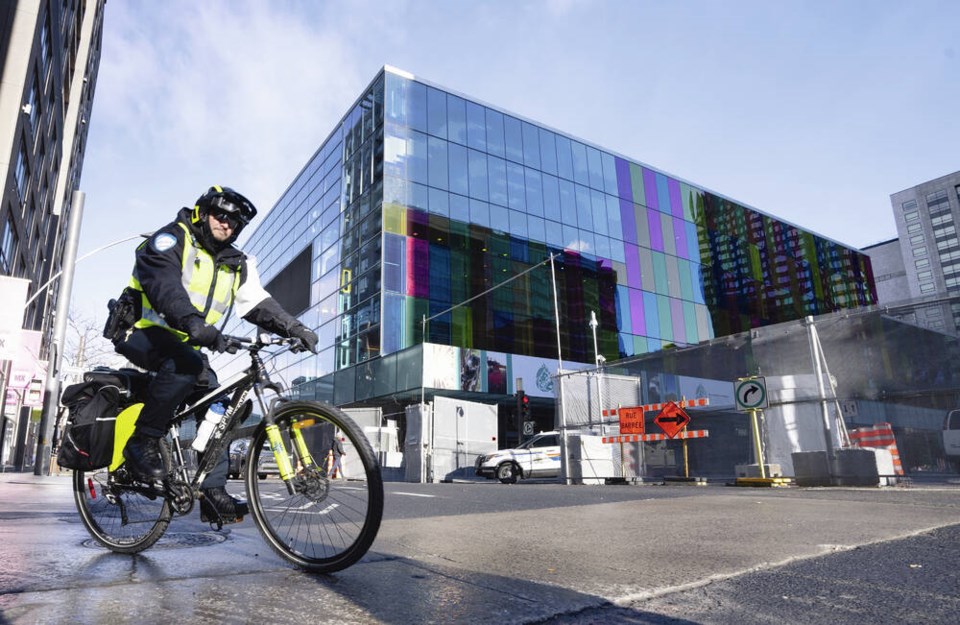Courtesy of the Times Colonist
Photo: A police officer rides around the fenced-off perimeter of the Montreal Convention Centre ahead of the COP15 UN conference on biodiversity this week. Paul Chiasson, The Canadian Press
Speaking at the Stockholm+50 conference in June, UN Secretary General Antonio Guterres identified a “triple planetary crisis” — climate change, biodiversity loss and pollution.
The first of these — climate change — was the subject of the UN’s 27th Climate Summit (COP27) in Sharm el Sheikh last month.
The second — biodiversity loss — is the subject of the 15th Conference of the Parties to the Convention on Biological Diversity (COP15), which began in Montreal this past week.
The web of life is absolutely fundamental to our health and wellbeing — indeed, to our very existence.
The air we breathe, the water we drink, the food we eat, the materials and energy we use — they all come from nature. We are part of the web of life, and as the Duwamish elder Chief Seattle is recorded as saying more than 150 years ago: “Whatever we do to the web of life, we do to ourselves.”
The degradation of nature and the loss of biodiversity — the loss of the other beings that are, as Indigenous people put it, “all our relations” — is a degradation of and loss to humanity, an existential threat to society, and indeed to humanity as a whole.
As an editorial in The Lancet Planetary Health journal put it, the global biodiversity crisis is “one of the great threats to planetary health.”
The scale of biodiversity loss is dramatic and unnerving, but is not widely understood and has not generated as much public concern as it should.
The 2020 report Global Biodiversity Outlook 5 (GBO-5) stated: “Biodiversity is declining at an unprecedented rate, and the pressures driving this decline are intensifying.”
Those pressures include economic growth, population growth, unsustainable resource extraction (forests, fisheries and the like) and an unsustainable high-meat diet.
The GBO-5 was also a report on the world’s progress in achieving the 20 Aichi Biodiversity Targets that were adopted in 2010. None were fully met, and only six were even partially met.
So while the intention at COP15 is to agree to a new global biodiversity framework for the next decade, it will be actions, not words, that matter.
This loss of biodiversity is also seen in Canada and in B.C. A joint report released this month by the federal, provincial and territorial governments finds Canada is home to about 80,000 species (not including bacteria or viruses).
The report covers 50,534 species; however, there is only enough data available to provide an assessment for 24,483 species.
Of these, one in five are either critically imperilled, imperilled or vulnerable, while 128 species — mainly plants and insects — are considered extirpated (likely disappeared from Canada, but still found elsewhere), while seven, not found elsewhere, are considered extinct globally.
One of the keys to biodiversity conservation is habitat protection. Canada is steward of the second-largest remaining areas of intact nature in the world, and in 2020 Canada pledged to protect 30 per cent of our lands and waters by 2030.
But at the time, Canada was only protecting 12 per cent, and a 2022 statement from Environment Canada reports “at the end of 2021, Canada had conserved 13.5 per cent of its land area [and] 13.9 per cent of its marine territory.”
Given that “expanding to 30 per cent from 12 per cent means adding an area roughly equivalent to Alberta, Saskatchewan and Manitoba combined,” according to UBC researcher Matthew Mitchell, it seems unlikely that target will be reached.
And it is certainly not helped by the outrageous plans by the Ontario government to pave over large parts of Toronto’s greenbelt for housing, which will also worsen urban sprawl.
As for B.C., which a November report from the Wilderness Committee and Sierra Club B.C. notes is “home to the highest amount of biodiversity in Canada, but also home to the greatest number of species at risk,” their report finds current federal and provincial legislation is not safeguarding biodiversity and species at risk.
Most glaringly, of course, is former premier John Horgan’s failure to keep his 2017 commitment to bring in a Species at Risk Act. For the sake of all of us, and all our relations, let’s hope Premier David Eby has more integrity and a greater commitment to protect and restore B.C.’s environment and biodiversity than his predecessor.
thancock@uvic.ca
Dr. Trevor Hancock is a retired professor and senior scholar at the University of Victoria’s School of Public Health and Social Policy.
